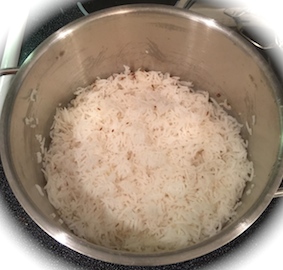Rice
Rice deserves its very own category. Around our place, it's a staple served with almost every meal. And boy, is it ever easy to get wrong! Nothing is worse than rice with some raw grains mixed in with mushy ones. I can't promise it won't happen to you, but I can tell you how to reduce the possibility:
First of all, buy good-quality basmati rice. Good rice has a greater "window of success"…a bigger range of things you can do to it and still have it come out perfectly. And what does success look like for basmati rice? A bowlful of steaming, separate, long grains, with each and every grain perfectly done but not overdone or sticky - and a delicious, nutty flavour that makes you want to eat it all on its own, or perhaps with just a dollop of yogurt and a sprig of green onion.

Second, your cooking pot is very important. You'll want a pan with a good lid. You also want a dutch oven-type pot as opposed to a deep stock pot. (You want a high ratio of bottom surface to pan depth, otherwise you'll get mushy grains for sure, because you just can't bring the rice and water up to heat fast enough).
Good luck!Ingredients
1.5 cups basmati rice
water
1 tsp salt or to tastevegetable oil
1/2 tsp cumin seed
First of all, measure your rice into a bowl and pour in some lukewarm water to nearly fill the bowl. Using your hands, swish the grains around. The water will start to go milky as the starch is released from the grains. Drain off the rinse water, and repeat the process. I rinse my rice five times. After five rinsings, fill the bowl with lukewarm water and let the rice soak for 15 minutes.
Put a kettle of water to boil. Heat your pan to medium-high (5 or 6). Add oil to almost cover the bottom of the pan. Heat it up until the oil is hot, but not yet shimmering. Add the cumin seeds. They will sizzle a bit. Now add the drained rice. Stir it gently for a minute or two to (hopefully) coat the grains and seal in the starch. Now add 1 3/4 cups of the boiling water and stir gently. Raise the heat a notch or two, because you want the water to boil quickly. Add the salt. Now take a look. If all of the grains are submerged in the water, with just a few of them able to make it to the surface during boiling, then you have enough water in the pot. If many grains are not submerged, you need to add a little bit of water. Keep adding water until you reach that state where you can only see a few brave grains of rice swimming up to the surface during the boil. If you've kept to the amounts above, you won't need to add much: maybe a tablespoon or two. Now cover the pot, and turn it down to simmer.
After 15 minutes, carefully (steam!) remove the lid and fluff the rice with a fork. Try to fluff all the way to the bottom where the mush can form. If the rice seems nearly all done, turn off the heat, leaving it to sit on the burner for another 10 minutes or so.